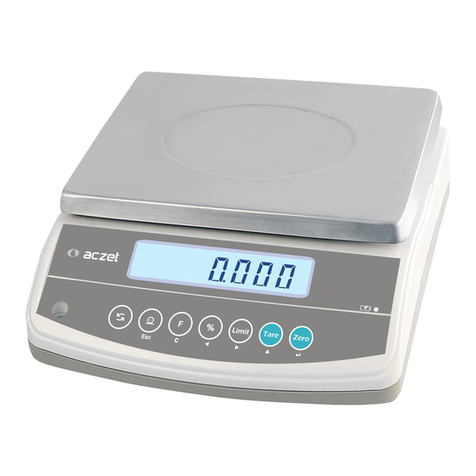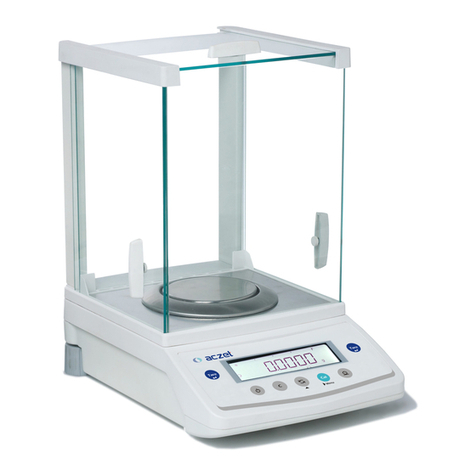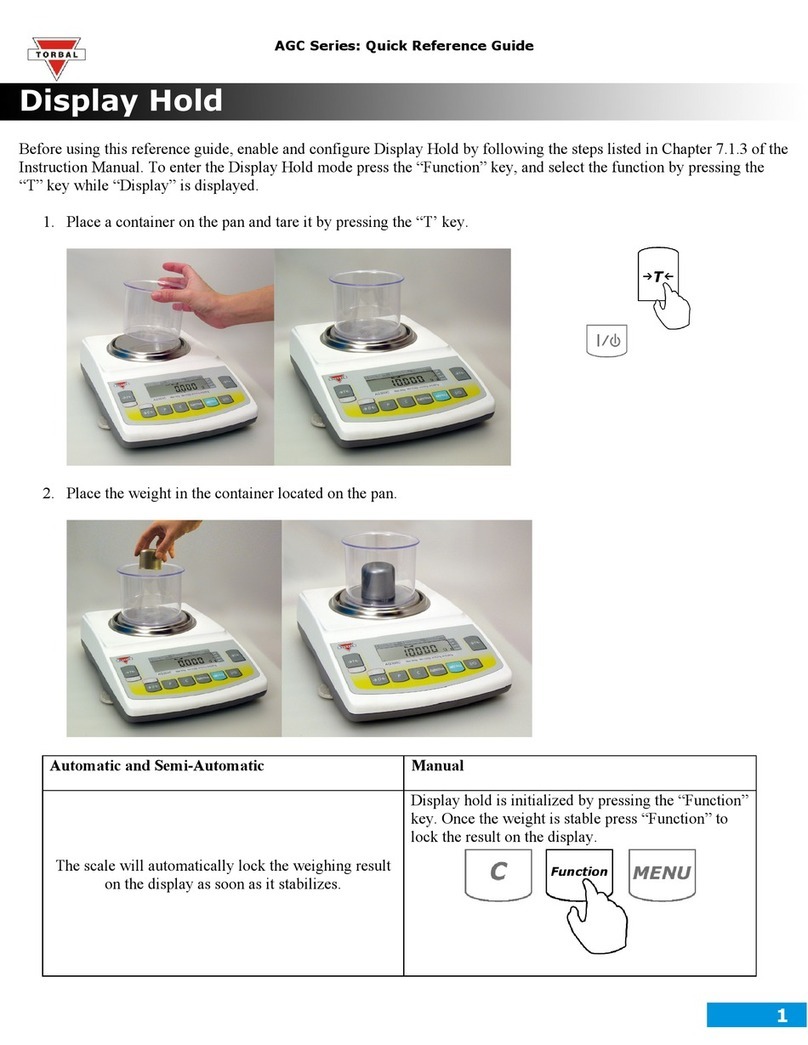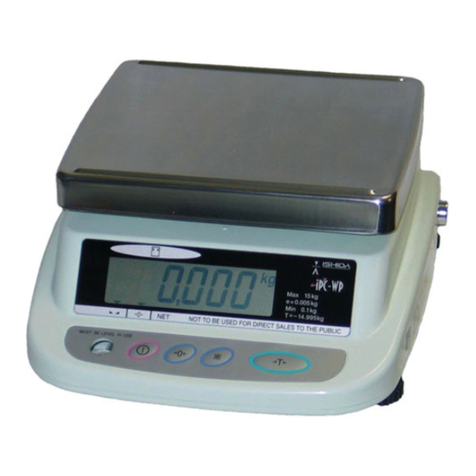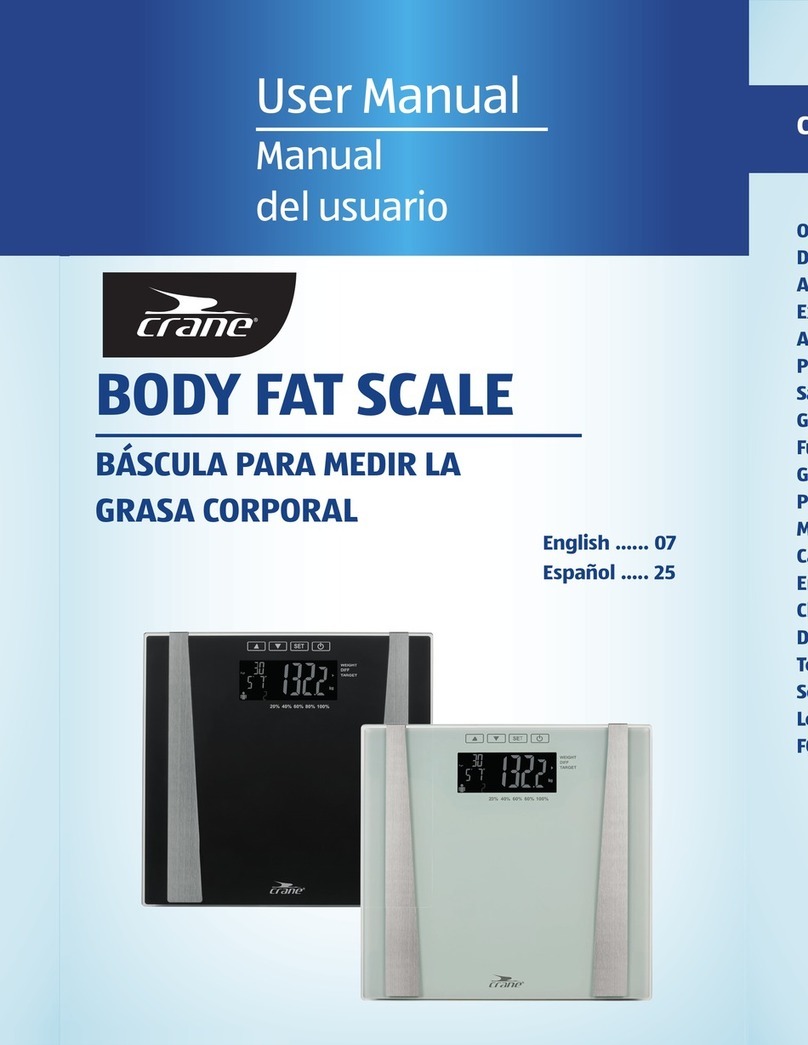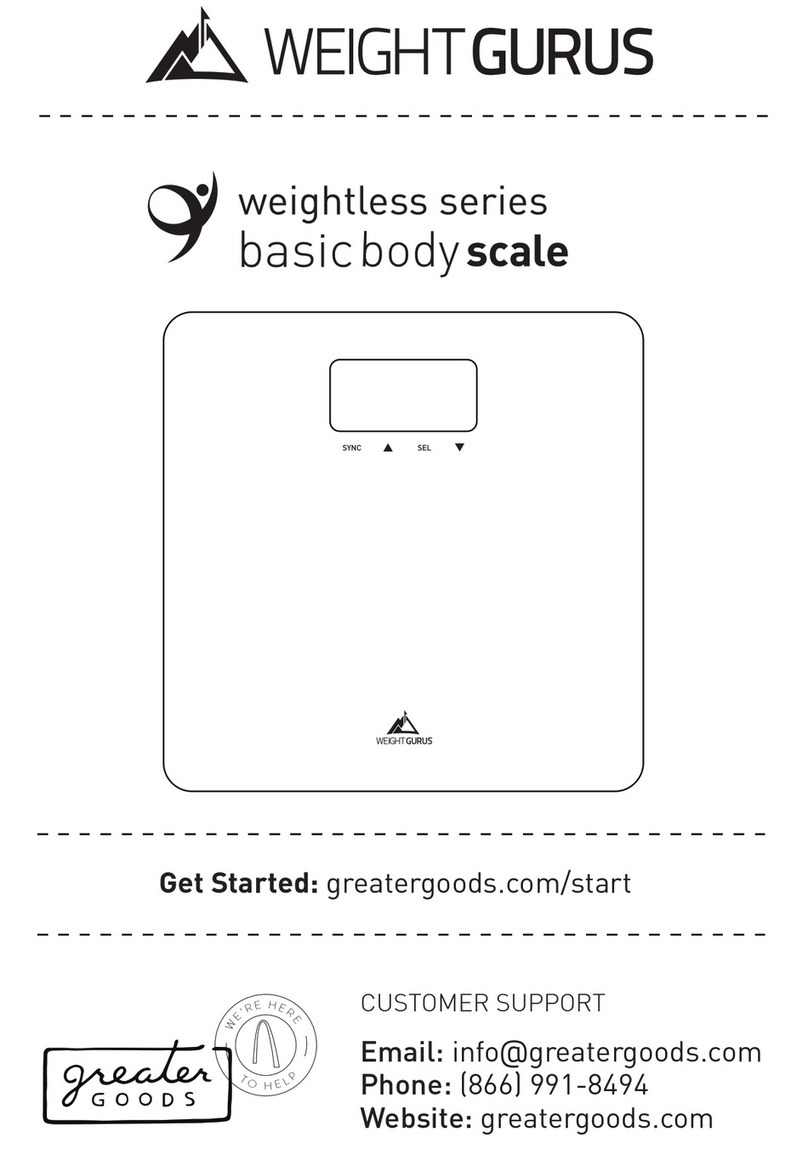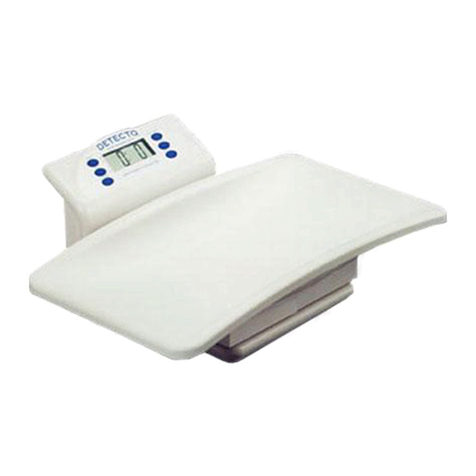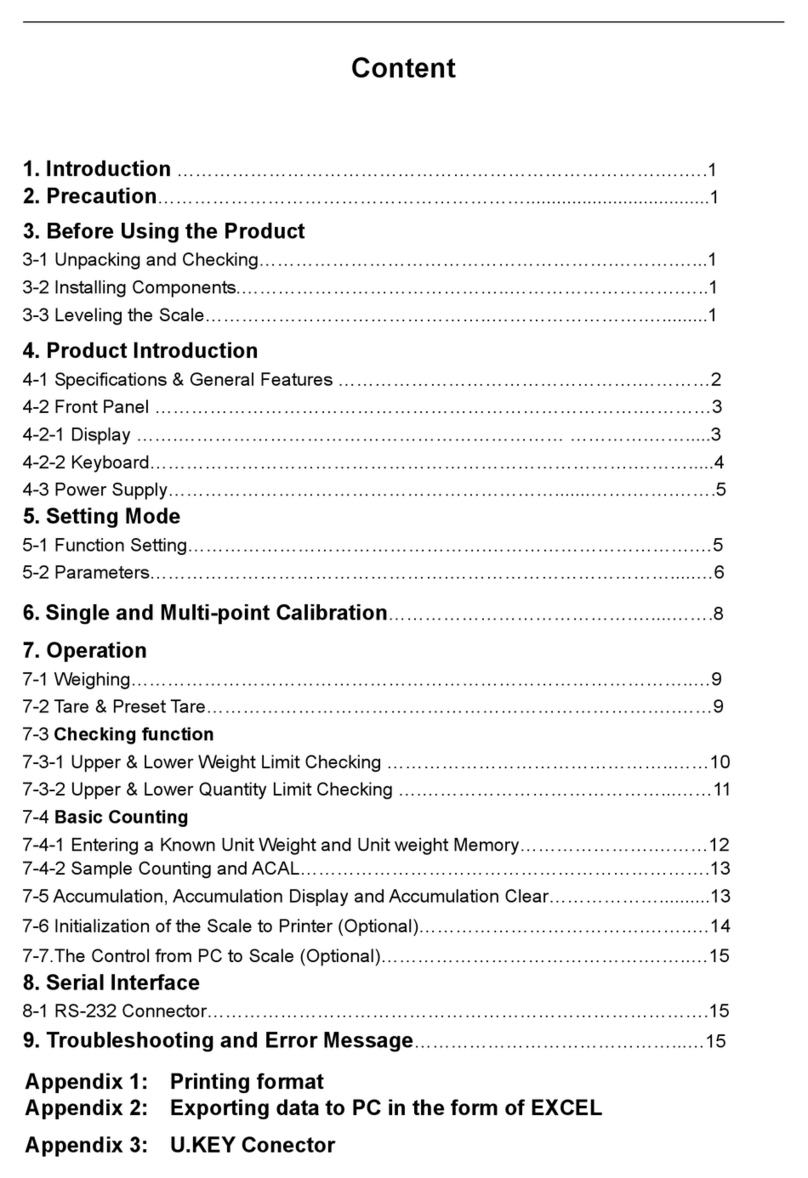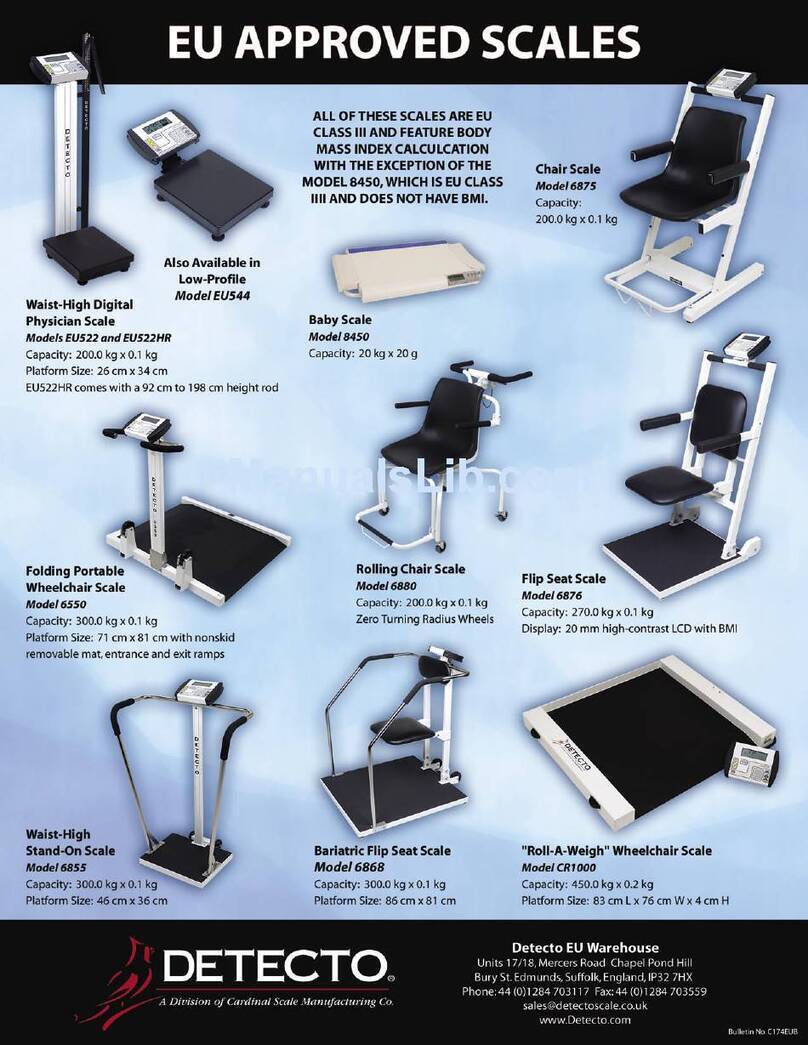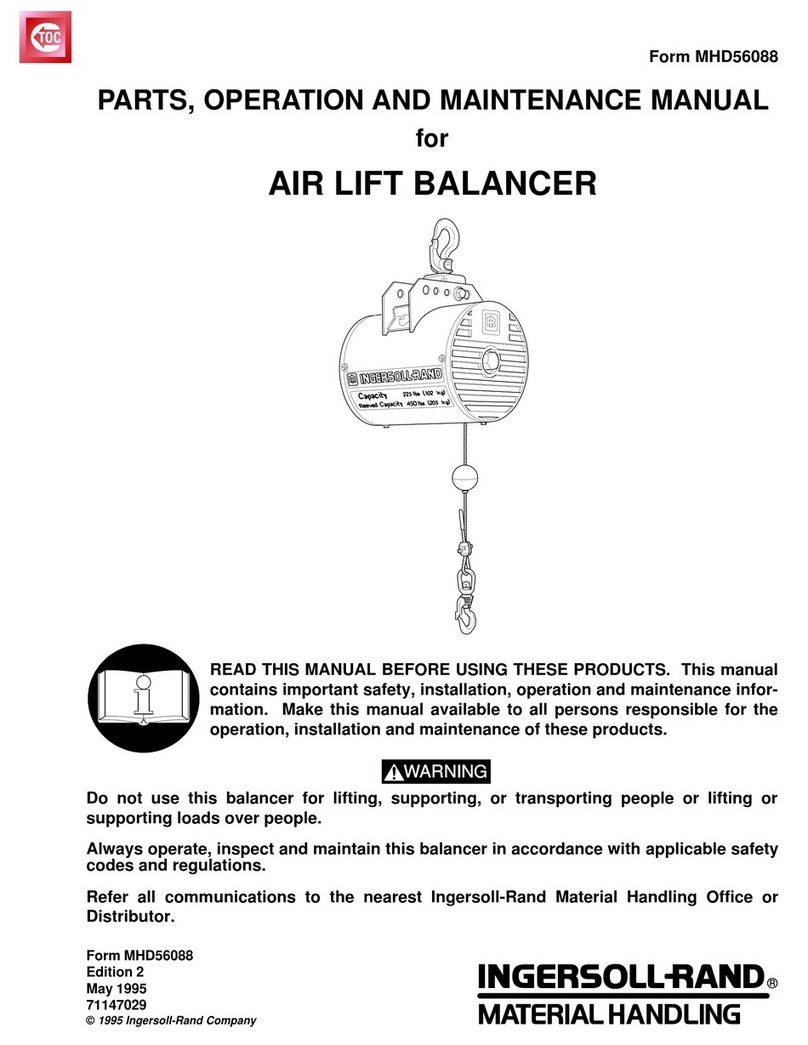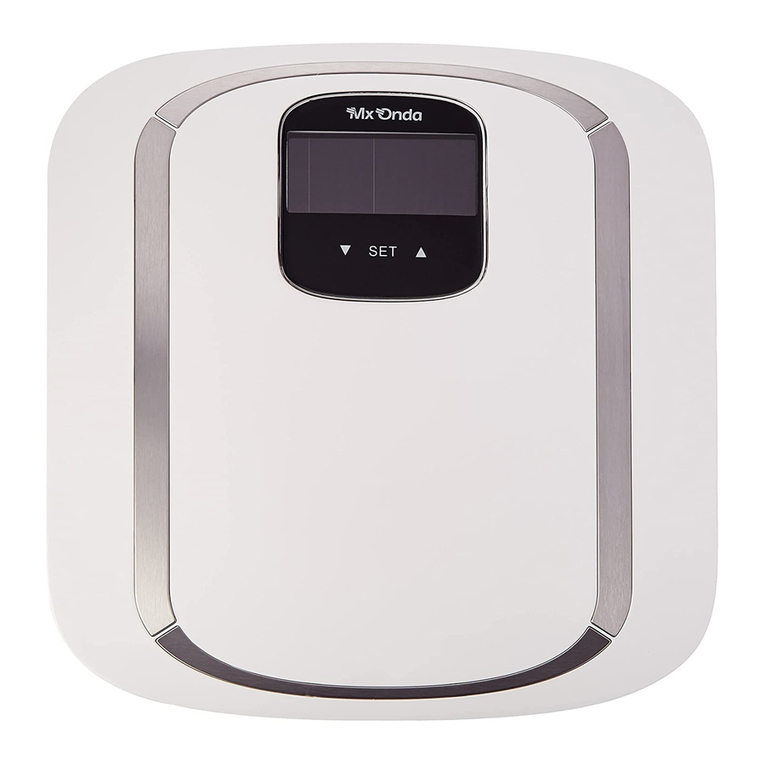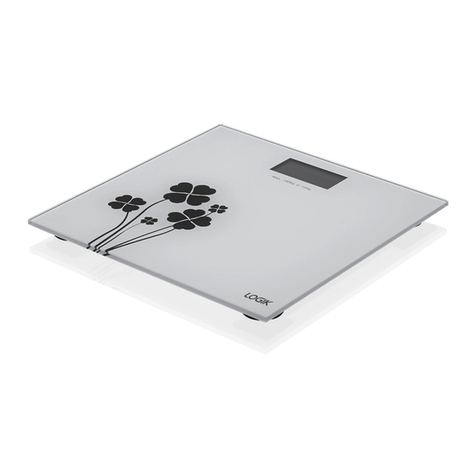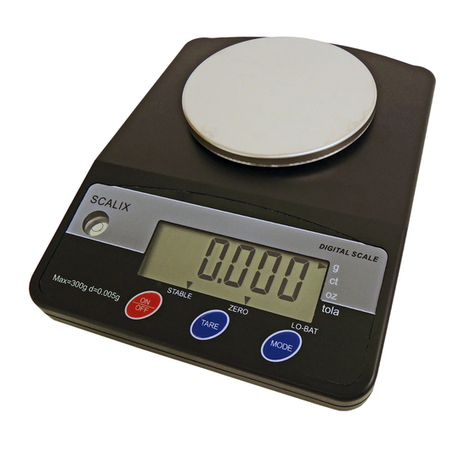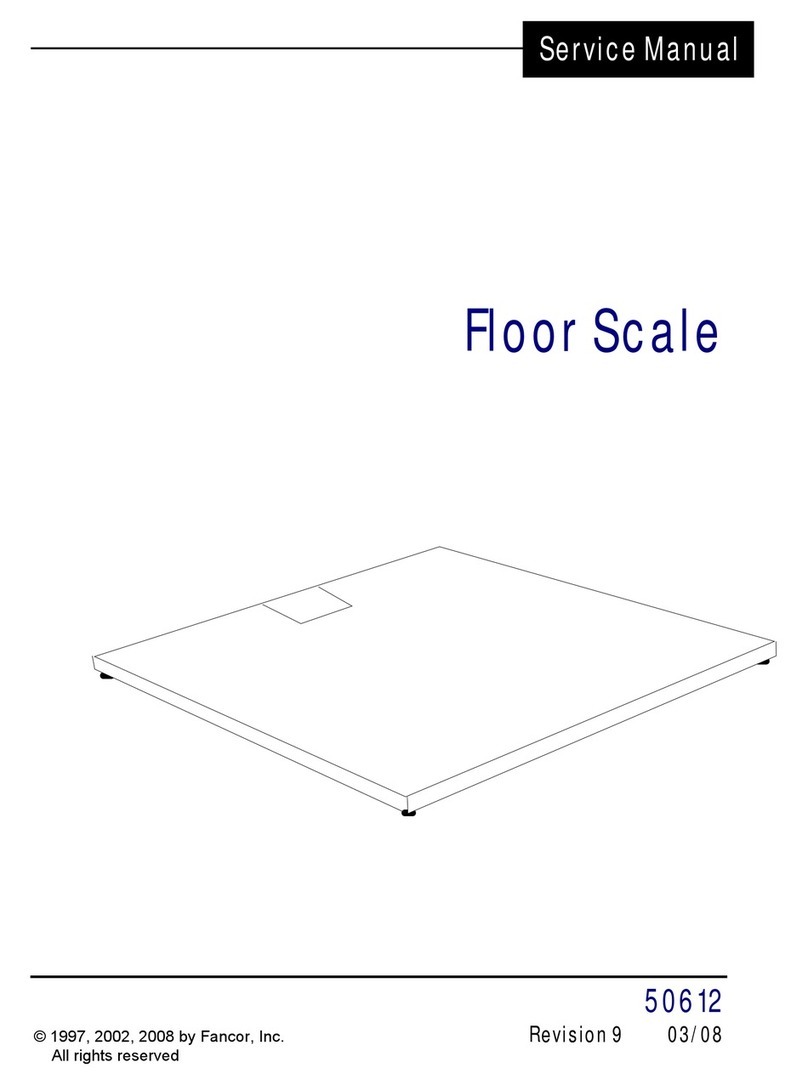Aczet CZ Series User manual

USA
Aczet Inc.
1637 STELTON ROAD, UNIT B5, Piscataway, NJ 08854 , USA
Direct :+ 1-732.777.0900 | Fax: + 1-732.777.0901 | Toll Free : 18009971440
Email: [email protected]
UAE
Aczet Instruments LLC
P.O. Box 27137, Deira - Dubai, United Arab Emirates
Tel: +971 4 2255266/2258929 | Fax : +971 4 2354665 | Cell: +971 50 6593253
Thailand
Aczet (Thailand) Co. Ltd.
3A1, 3rdfloor, BIS Building, 119 Mahesak Road, Suriyawong,
Bangrak, Bangkok 10500, Thailand | Mob : (+66) 920456757 | Off : (+66) 26359620
India
Aczet Pvt. Ltd.
E2, Plot No. 15, WICEL, Opp. Seepz Gate No. 1, MIDC, Andheri (E), Mumbai 400 093. India
Tel. : +91-22-4243 7700 | Fax : +91-22-4243 7800 | Toll Free : 1800 102 6054
Desk Top Scale
CZ Series
This document hosted by: www.oldwillknottscales.com

14. Instant help
In case of an error in the program process, briefly turn off the balance and disconnect from power
supply. The weighing process must then be restarted from the beginning.
Help
Should other error messages occur, switch balance off and then on again. If the error message
remains inform manufacturer.
30
Fault Possible cause
The displayed weight does not
glow.
The displayed weight is
permanently changing
Th e wei g hi n g re s ul t is
obviously incorrect
Weight variation or calibration
failure
• The balance is not switched on.
• Mains power supply interrupted (mains cable defective).
• Power supply interrupted.
• Rechargeable battery inserted incorrectly or empty
• Draught/air movement
• Table/floor vibrations
• Weighing plate has contact with other objects.
• Electromagnetic fields / static charging (choose different
location/switch off interfering device if possible)
• The display of the balance is not at zero
• Adjustment is no longer correct.
• Great fluctuations in temperature.
• Warm-up time was ignored.
• Electromagnetic fields / static charging (choose
different location/switch off interfering device if
• Check transport Lock is removed or not, if any
• Prefer Linearity (see. chapter 9.2)
Contents

29
Error massage Description Possible causes
Zeroing range exceeded due to
switching-on balance or pressing
(normally 4% max)
Keyboard error
Value outside the A/D changer range
• Object on the weighing plate
• Overload when zeroing
• Improper adjustment
• Damaged weighing cell
• Damaged electronics
• Improper operation of the balance
• Damaged weighing cell
• Damaged electronics
13.5 Error messages
Should other error messages occur, switch balance off and then on again. If the error message
remains inform manufacturer.

28
13. Service, maintenance, disposal
13.1 Cleaning
Before cleaning, disconnect the appliance from the operating voltage.
Please do not use aggressive cleaning agents (solvents or similar agents), but a cloth dampened
with mild soap suds. Take care that the device is not penetrated by fluids and polish it with a dry soft
cloth.
Loose residue sample/powder can be removed carefully with a brush or manual vacuum cleaner.
Spilled weighing goods must be removed immediately.
13.2 Service, maintenance
The appliance may only be opened by trained service technicians who are authorized by ACZET.
Before opening, disconnect from power supply.
13.3 Disposal
Disposal of packaging and appliance must be carried out by operator according to valid national or
regional law of the location where the appliance is used.
13.4 Replacement Parts
Part Number Description
MH12R98601 G Replacement Battery
MH12R98602G Power Cord
CZ 3
0.1 g
3 kg
0.1 g
± 0.2 g
2 s
kg, g
2 kg (F1)
1 kg (F1)
30 min
0.1 g
CZ 30
1 g
30 kg
2 g
± 1 g
2 s
kg, g
20 kg (M1)
10 kg (M1)
10 min
1 g
CZ 15
0.5 g
15 kg
0.5 g
± 0.5 g
2 s
kg, g
10 kg (F2)
5 kg (F2)
20 min
0.5 g
0° C to 40° C
max. 80 % relative (not condensing)
294 x 225
320 x 330 x 125
220V-240V AC 50 Hz / 12 V, 500 mA
Working life approx. 40 h (with background light)
Working life approx. 90 h (without background light)
Charging time approx. 12 hrs.
3.06 kg
RS 232 (Optional)
Aczet
Readability (d)
Weighing range (max)
Reproducibility
Linearity
Stabilization time
Weighing Units
Recommended adjusting
weight (not supplied)
Warm-up time
Minimum unit weight
at piece count
Admissible ambient
conditions
Humidity of air
Weighing surface (mm)
Dimensions of the
housing (BxDxH) (mm)
Electric Supply
Rechargeable battery,
not included
Net weight (kg)
Interface
CZ 6
0.2 g
6 kg
0.2 g
± 0.2 g
2 s
kg, g
5 kg (F1)
1 kg (F1)
30 min
0.2 g
1
1. Technical Data

CZ 6H
0.1 g
6 kg
0.1 g
± 0.2 g
2 s
0.1 g
III
20 g
g, kg
5kg(F1)
1kg(F1)
30 min.
0.2 g
CZ 30H
0.5 g
30 kg
0.5 g
± 0.5 g
2 s
0.5 g
III
100 g
g, kg
20kg(F2)
10kg(F2)
20 min.
0.5 g
CZ 30S
2 g
30 kg
2 g
± 2 g
2 s
2 g
III
100 g
g, kg
20kg(M2)
10kg(M2)
10 min.
2 g
CZ 20H
0.1 g
20 kg
0.1 g
± 0.2 g
2 s
0.1 g
III
100 g
g, kg
20kg(F2)
30 min.
0.5 g
CZ 15H
0.1 g
15 kg
0.1 g
± 0.2 g
2 s
0.1 g
III
40 g
g, kg
10kg(F2)
5kg(F2)
30 min.
0.5 g
CZ 15S
1 g
15 kg
1 g
± 1 g
2 s
1 g
III
40 g
g, kg
10kg(M1)
5kg(M1)
10 min.
1 g
Aczet
Readability (d)
Weighing range (max)
Reproducibility
Linearity
Stabilization time
Verification value (e)
Verification class
Minimum weight (min)
Weighing Units
Recommended adjusting
weight (not supplied)
Warm-up time
Minimum unit weight
at piece count
Admissible ambient
conditions
Humidity of air
Weighing surface (mm)
Dimensions of the
housing (BxDxH) (mm)
Electric Supply
Rechargeable battery,
not included
Net weight (kg)
Interface
-10° C to +40° C
max. 80 % relative (not condensing)
294 x 225
320 x 330 x 125
220V-240V AC 50 Hz / 12 V, 500 mA
Working life approx. 40 h (with background light)
Working life approx. 90 h (without background light)
Charging time approx. 12 hrs.
4.4 kg
RS 232 (Optional)
2
27
Header1 ,Header2 ,-/space W1 W2 W3 W4 W5 W6 W7 unit terminator
,
Header1
Header2
space
W1-W7
Unit
Terminator
2 byte, St or US, ST=weighing value stable, US=weighing value instable
2 byte, G or N, G=gross weight, N= net weight
Blank
Weight value with decimal position
2 byte, kg or lb
<CR> <LF> (CR=Carriage return)
(LF= Line Feed
12.1.3 Explanation of the data transfer
Example :

26
*default setting
12. Data output
12.1 RS232 interface (optional)
The RS 232 interface allows a bi-directional data exchange from the balance to external devices.
This data exchange is asynchronous using ASCII - Code.
12.1.1 Technical data
• ASCII code
• 8 data bits
• Baud rate selectable at 600, 1200, 2400, 4800, 9600 bps
• Miniature plug-in necessary (9 pole D-Sub)
• No parity
• For operation with interface faultless operation is only ensured with the correct ACZET
interface cable (max. 2m)
12.1.2 Pin allocation of balance output bushing:
Pin 2 : Output
Pin 3 : Input, not use
Pin 4 : Signal ground
3
Dimension
2. Basic Information
2.1 Proper use
The balance you purchased is intended to determine the weighing value of material to be weighed.
It is intended to be used as a "non-automatic" balance, i.e. the material to be weighed is manually
and carefully placed in the centre of the weighing plate. As soon as a stable weighing value is
reached the weighing value can be read.
2.2 Improper Use
Do not use balance for dynamic weighing. In the event that small quantities are removed or added
to the material to be weighed, incorrect weighing results can be displayed due to the "stability
compensation" in the balance.
(Example: Slowly draining fluids from a container on the balance.)
Do not leave permanent load on the weighing plate. This may damage the measuring system.
Impacts and overloading exceeding the stated maximum load (max) of the balance, minus a
possibly existing tare load, must be strictly avoided. Balance may be damage by this.
Never operate balance in explosive environment. The serial version is not explosion protected.
The structure of the balance may not be modified. This may lead to incorrect weighing results,
safety-related faults and destruction of the balance.
The balance may only be used according to the described conditions. Other areas of use must be
released by ACZET in writing.

4
2.3 Warranty
Warranty claims shall be voided in case
• Our conditions in the operation manual are ignored
• The appliance is used outside the described uses
• The appliance is modified or opened
• Mechanical damage or damage by media, liquids, natural wear and tear
• The appliance is improperly set up or incorrectly electrically connected
• The measuring system is overloaded
3. Basic Information
3.1 Pay attention to the instructions in the Operation Manual
Carefully read this operation manual before setup and commissioning, even
if you are already familiar with ACZET balances.
Versions in other languages are non-binding translations.
The only binding version is the original documents in German.
3.2 Personnel training
The appliance may only be operated and maintained by trained personnel.
3.3 Precautions
• Always place the scale in a rigid and vibration free surface.
• Avoid any direct flow of air on the pan it can lead to errors during weighing.
• Calibrate the scale at regular intervals and after a long period of use.
• Check level indicator before use. The level bubble should be at the center.
A2 2d*
EL Au... off*
Background light
bEEP1*
Audio signal
Apd 15*
Display speed
oF 0*
Auto off
return*
tP*
Printout
Ut on*
Ut on*
ACC on*
Add-up mode
b 4800*
Baud rate
Au off*
Add-up mode
A 0,5d
EL on
0
SPd 15
tP
ACC on
Au on
Au oFF
not documented
Background lighting on
No audio sound during tolerance weighing
not documented
Auto off after 0, 3, 5, 15 or 30 minutes
Return to weighing mode
Output of weighing value
not documented
Add-up mode on
Setting options for baud rate : 600 / 1200 / 2400 / 4800 / 9600
Automatic add-up mode :
Automatic add-up and editing to printer/PC
Manual add-up mode:
Totalizing and editing to printer/PC by pressing
Background lighting off
Audio sound when weight is beyond tolerance range
Background light automatic off
Audio sound when weight is within tolerance range
Aczet-Label-Printer
not documented
Add-up mode off
Continuous data output
A 1d
EL Au
1
SPd 30
LP 50
ACC off
P Con
A 2d
EL off
2
SPd 60
A 4d
25
11.2 Overview
*default setting

24
11. The Menu
11.1 Navigation in the menu:
Call up menu
Select menu block
Change Setting
Acknowledge setting /
exit the menu
Return to weighing mode
In weighing mode press and at the same time The first
menu item InC 5 will be displayed
• With help of , the individual menu items can be selected
one after the other.
• Switch into the available setting using .
• Either save by pressing or cancel by pressing .
• Press to exit menu .
5
4. Transportation & Storage
4.1 Testing upon acceptance
When receiving the appliance, please check packaging immediately, and the appliance itself when
unpacking for possible visible damage.
4.2 Packaging / return transport
Keep all parts of the original packaging for a possibly required return.
Only use original packaging for returning.
Prior to dispatch disconnect all cables and remove loose / mobile parts.
Reattach transport securing devices. (see chapter 5.2)
Secure all parts such as the glass wind screen, the weighing platform, power
unit etc. against shifting and damage.
5. Unpacking, Setup and Commissioning
5.1 Installation Site, Location of Use
The balances are designed in a way that reliable weighing results are achieved in common
conditions of use.
You will work accurately and fast, if you select the right location for your balance.
Therefore, observe the following for the installation site:
• Place scales on a stable, even surface
• Avoid extreme heat as well as temperature fluctuation caused by installing next to a radiator or
in the direct sunlight;
• Protect the balance against direct draughts due to open windows and doors;
• Avoid jarring during weighing;
• Protect the balance against high humidity, vapors and dust;
• Do not expose the device to extreme dampness for longer periods of time. Non-permitted
condensation (condensation of air humidity on the appliance) may occur if a cold appliance is
taken to a considerably warmer environment. In this case, acclimatize the disconnected
appliance for ca. 2 hours at room temperature.
• Avoid static charge of goods to be weighed or weighing container.
Major display deviations (incorrect weighing results) may be experienced should electromagnetic
fields (e.g. due to mobile phones or radio equipment), static electricity accumulations or instable
power supply occur. Change location or remove source of interference.

6
5.2 Unpacking/installation
Carefully remove the balance from the packaging, remove plastic cover and setup balance at the
intended workstation.
Ensure that transport guard has been removed (only existing in 6kg & 3kg
models)
To loosen the transport guard screw out transport screw [1] anticlockwise.
For transportation screw down the transport screw till to the stop in clockwise direction.
Levelling
Level balance with foot screws until the air bubble of the water balance is in
the prescribed circle.
5.2.1 Scope of delivery / serial accessories
• Balance
• Mains power supply
• Operating instructions
5.3 Mains connection
Power is supplied via the external mains adapter. The stated voltage value must be the same as the
local voltage.
Only use original ACZET mains adapters. Using other makes requires consent by ACZET.
1
23
10.8 Below Weighing Arrangement
• This balance is present with an arrangement for below weighing. If there is any need that the
user wants to weigh from below they can use the below weighing hook provided with the
balance.
• Take out the below weighing hook
provided in the balance box.
• Fit the below weighing hook in the slot
provided at the back side of the
balance(refer image)
• Now screw the below hook in the slot
provided.
• Now it is ready for below weighing.
INSTRUCTIONS TO USE BELOW WEIGH HOOK

Display of the saved weighing data
• With the weighing platform unloaded, press and the number of weighing processes,
followed by the total weight will be displayed for 2 sec and afterwards printed.
Delete weighing data:
• With the weighing platform unloaded, press followed by . The data in the
summation memory are deleted.
1st weighing:
No. 1
G 0.200 kg
C 0.200 kg
2. weighing
No. 2
G 0.050 kg
C 0.250 kg
3. weighing
No. 3
G 2.000 kg
C 2.250 kg
****************************
Number of weighings / total:
No. 3
C 2.250 kg
****************************
Printout example
22
The two following items limit the totalizing process.
• totalize max. 99 times.
• number of digits displayed
7
5.4 Rechargeable battery operation (option)
The internal battery is charged with the supplied mains cable.
Before the first use, the rechargeable battery should be charged by connecting it to the mains power
cable for at least 15 hours. The operating time of the battery is about. 90h. Charging time until
complete recharging ca. 12h.
To save battery life, the background light can be switched off in the menu (See chap.. 11 menu).
An arrow [▲] appearing on the weight display below the battery icon indicates that the
capacity of the rechargeable battery is low. The balance will be ready to operate for about another
10 hrs., then it will switch off automatically. Connect the power cable as soon as possible to load
the rechargeable battery.
5.5 Connection of peripheral devices
Before connecting or disconnecting of additional devices (printer, PC) to the data interface, always
disconnect the balance from the power supply.
With your balance, only use accessories and peripheral devices by ACZET, as they are ideally
tuned to your balance.
5.6 Initial Commissioning
In order to obtain exact results with the electronic balances, your balance must have reached the
operating temperature (see warming up time chap. 1).
During this warming up time the balance must be connected to the power supply (mains,
accumulator or battery).
The accuracy of the balance depends on the local acceleration of gravity.
Strictly observe hints in chapter Calibration.

21
10.7 Automatic adding-up
This function is used to automatically add individual weighing values to the summation memory
and to receive a printout from a possibly connected optional printer.
For details on how to set this function see chap. 11 menu: „ACC on")
• Place load A
After stabilisation control has taken place, you will hear an audio
sound. The weighing value will be saved to the summation memory.
• Remove load A
ACC 1, followed by the weighing value will be displayed and
possibly printed.
Afterwards the weighing scales change to zero display.
• Place goods to be weighed B.
After the standstill control sounds a signal tone.
The weighing value is added into the total adding memory.
• Remove load B
• ACC 2, followed by the total weight will be displayed and possibly
printed.
Afterwards the weighing scales change to zero display.
• Add more weighed goods as described before.
Please note that the balance must be unloaded between the individual
weighing procedures.
• You can repeat this process until the capacity of the scales is
exhausted.

20
Display of the save weighing data
• With the weighing platform unloaded, press and the number of weighing processes,
followed by the total weight will be displayed for 2 sec and afterwards printed.
Delete weighing data:
• With the weighing platform unloaded, press followed by . The data in the
summation memory are deleted.
1st weighing:
No. 1
G 0.200 kg
C 0.200 kg
2. weighing
No. 2
G 0.050 kg
C 0.250 kg
3. weighing
No. 3
G 2.000 kg
C 2.250 kg
****************************
Number of weighings / total:
No. 3
C 2.250 kg
****************************
Printout example
8
9
HI
OK
LO
ZERO
NET
Gross
Display
1
2
3
4
5
6
7
The battery capacity display
Stability Display
Zeroing display
Net weight display
Gross weight Display Showing gross weight
Displays the net weight
Tolerance check checkweighing Load above (HI), below (LO) or
within (OK) tolerance range
Power supply connected Icon is glowing for power supply
via power pack.
Appears when the capacity of the
battery is getting low
Scales are in a steady state
Designation Description
Should the balance not display
exactly zero despite empty scale
pan, press the button.
The balance will be set to zero
after a short standby time.
7. Overview of displays

Butoon
1
2
3
4
5
6
7
Unit-Key
Print button
Function key
Percentage key
Tolerance key
Check-weighing
Tare Key
Zeroing key
Designation Function
Weighing units switch-over
Print : Data transfer via interface
Save value to memory if memory
function automatic is disabled
ESC : Return to weighing mode
F : Changes between weighing mode and
quantity counting mode
C : Delete displayed value
% : Weight value displayed in %
: Move to the left by one decimal point
TOL : Enter upper, lower or both limits
: Move to the right by one decimal point
Tare : Tare balance
: Increase displayed value
0 : Reset scales to zero
: Confirm entered value or select function
8. Keyboard overview
10
19
10.6 Manual totalizing
This function is used to add the individual weighing values to the summation memory and, if a
printer is connected to provide a printout when the stability display appear and the key
pressed.
(For details how to set this function see chap. 11 menu "ACC on")
• Place load A
Wait until stability display appears
• Press
ACC 1 followed by the weighing value will appear and the weighing
value will be saved to the summation memory and possibly printed.
• Remove load A
Further loads can only be added after the display has returned to zero.
• Place load B
Wait until stability display appears
• Press again
ACC 2, followed by the total weight will be displayed and the
weighing value added to the summation memory and possibly
printed.
• Remove load B
Further loads can only be added after the display has returned to zero.
• Add more weighed goods as described before. Please note that the
balance must be unloaded between the individual weighing
procedures.
• You can repeat this process until the capacity of the scales is
exhausted

18
Setting
Weighing with tolerance range
• Tare when using a weighing container
• Put on goods to be weighed, tolerance control is started
• Unload scales and set to zero
• Press
The left digit will be flashing and icon HI will be displayed
• Enter upper limit by pressing and .
• Confirm upper limit by pressing .
The weighing scales will change to the prompt for entering the lower
limit.
• Enter lower limit by pressing and
• Confirm lower limit by pressing .
• The scales will change to zero display.
To reset the enter value to zero, Press
• The tolerance control is not active when the weight is under 20d.
• To finish tolerance weighing, set both limit to zero by pressing
11
9. Calibration
As the acceleration value due to gravity is not the same at every location on earth, each balance
must be coordinated - in compliance with the underlying physical weighing principle - to the
existing acceleration due to gravity at its place of location (only if the balance has not already been
adjusted to the location in the factory). This adjustment process must be carried out for the first
commissioning, after each change of location as well as in case of fluctuating environment
temperature. To receive accurate measuring values it is also recommended to adjust the balance
periodically in weighing operation.
9.1 Calibration Procedure
• Switch on balance Whilst balance is carrying out self-test (counts
down from 99… to 00…) and press at the same time.
“UnLoad” will be displayed, followed by flashing numeric value.
• Change by pressing the navigation keys (See manual chap. 8); select
desired setting; currently enabled digit will be flashing.
• Confirm value by “Load“ will be displayed.
• Place adjustment weight, stability display appears
• Now press key to confirm the calibration.
• After the adjustment the balance will carry out a self-test. Remove
adjusting weight during self test, balance will return into weighing
mode automatically. In case of an adjustment error or incorrect
adjusting weight the display will show an error message, repeat
adjustment process.
(Example)
(Example)

1312
9.2 Linearization
Linearity shows the greatest deviation of a weight display on the scale to the value of the respective
test weight according to plus and minus over the entire weighing range.
If linearity deviation is discovered during a testing instrument control, you can improve this by
means of linearization.
• Carrying out linearization is restricted to specialist staff possessing well acquainted with the
workings of weighing scales.
• The test weights to be used must be adapted to the weighing scale's specifications.
• Observe stable environmental conditions. Stabilisation requires a certain warm-up time.
• After successful linearization you will have to carry out calibration.
Tab. 1: Linearization points
Adjustment Weight
1
2
3
4
3 kg Model
0 kg
1 kg
2 kg
3 kg
6 kg Model
0 kg
2 kg
4 kg
6 kg
15 kg Model
0 kg
5 kg
10 kg
15 kg
30 kg Model
0 kg
10 kg
20 kg
30 kg
17
Printout example:
Parts counting:
G. 0.500 kg Reference weight
50 g/pcs Average parts weight
10 pcs Number of parts
10.5 Weighing with tolerance range
You can set an upper or lower limit when weighing with tolerance range and thus ensure that the
weighed load remains exactly within the set limits.
Exceeding or dropping below the tolerance range is indicated by an audio sound or optical signal.
Audio signal:
The audio sound depends on the setting in menu block “BEEP“ (See chap. 11 menu).
Options :
• 0 No audio sound during tolerance weighing
• 1 An acoustic signal sounds when load is within tolerance limits
• 2 An acoustic signal sounds when load is beyond tolerance limits
Optical signal:
The arrow symbols indicate whether load is within the two set limits.
The icons provide the following information:
1. Goods to be weighed above tolerance limit
2. Goods to be weighed within tolerance range
3. Goods to be weighed below tolerance limit
10.5 .1 Traffic light function
When using a traffic light, the following can be displayed :
red lamp Goods to be weighed above tolerance limit.
yellow lamp Goods to be weighed below tolerance limit.
green lamp Goods to be weighed within tolerance range.
HI
OK
LO
1
2
3

16
10.4 Parts counting
Before the balance can count parts, it must know the average part weight (i.e. reference). Proceed
by putting on a certain number of the parts to be counted. The balance determines the total weight
and divides it by the number of parts (the so-called reference quantity). Counting is then carried out
on the basis of the calculated average piece weight.
The higher the reference quantity the higher the counting exactness.
• Place the reference quantity
• Press , the scales will change to quantity counting mode
Reference quantity of 10, P 10 will appear.
• Reference quantities of 10, 20, 50, 100 and 200 can be set by
pressing .
• Confirm by pressing
You will briefly see a line on the screen before the scales show the
respective quantity
• To change between reference weight, total weight and quantity, press
the key.
• To return to weighing mode, press the key.
13
9.2.1 Linearization Procedure
In case of an adjustment error or incorrect adjusting weight the display will show an error message;
repeat linearization process.
• Place the second adjustment weight.
• After the apparition of the stability display, „LoAd 2“ will
be displayed
• Put on the third adjustment weight
• After the apparition of the stability display, „LoAd 3“ will be
displayed
• Put on the forth adjustment weight (max load)
• After the apparition of the stability display, „LoAd 2“ will be
displayed
• Third adjustment weight
• After the apparition of the stability display, „LoAd 1“ will be
displayed
• Second adjustment weight
• After the apparition of the stability display, „LoAd 0“ will be
displayed
• First adjustment weight (weighing plate empty)
• After successful linearization the balance automatically
returns to weighing mode.
How to carry out linearization:
• Switch on the balance and during the selftest press the and
the button at the same time. “LoAd 0“ followed by LoAd
1” will be displayed.
Operation Display

14
10. Operation
10.1 Weighing
Printout example :
N 0.500kg
10.2 Weighing with tare
• Turn on the scales by pressing the ON/OFF button underneath the
scales on the right.
The balance will carry out a self-test. The balance is ready for
weighing when the weight display „0.0“ appears.
When required, the scales can be reset to zero at any time using .
• Deposit weighing receptacles
• After successful stop check press the button.
The zero display and the symbol NET will appear. The weight of the
container is now internally saved.
• When the weighing container is removed, its weight will be shown as
a negative value.
• The taring process can be repeated any number of times, e.g. when
adding several components for a mixture (adding). The limit is
reached when the whole weighing range is exhausted.
• To delete the tare value, remove load from weighing plate and press
.
15
Printout example :
Net weight :
N 0.500kg
10.3 Percent weighing
Percent weighing allows to display weight in percent, in relation to a reference weight.
Printout example :
Percent :
G 199.99%
• Unload scales and set to zero
• Put a reference weight on the weighing plate, which corresponds to
100%
• Press
100.00 % will appear on the display
• Remove the reference weight
The display will return to 0.00 %
• Place a sample The display will show the percentage value of the
sample in relation to the reference value.
• To return to gram / kilo mode, press

14
10. Operation
10.1 Weighing
Printout example :
N 0.500kg
10.2 Weighing with tare
• Turn on the scales by pressing the ON/OFF button underneath the
scales on the right.
The balance will carry out a self-test. The balance is ready for
weighing when the weight display „0.0“ appears.
When required, the scales can be reset to zero at any time using .
• Deposit weighing receptacles
• After successful stop check press the button.
The zero display and the symbol NET will appear. The weight of the
container is now internally saved.
• When the weighing container is removed, its weight will be shown as
a negative value.
• The taring process can be repeated any number of times, e.g. when
adding several components for a mixture (adding). The limit is
reached when the whole weighing range is exhausted.
• To delete the tare value, remove load from weighing plate and press
.
15
Printout example :
Net weight :
N 0.500kg
10.3 Percent weighing
Percent weighing allows to display weight in percent, in relation to a reference weight.
Printout example :
Percent :
G 199.99%
• Unload scales and set to zero
• Put a reference weight on the weighing plate, which corresponds to
100%
• Press
100.00 % will appear on the display
• Remove the reference weight
The display will return to 0.00 %
• Place a sample The display will show the percentage value of the
sample in relation to the reference value.
• To return to gram / kilo mode, press

16
10.4 Parts counting
Before the balance can count parts, it must know the average part weight (i.e. reference). Proceed
by putting on a certain number of the parts to be counted. The balance determines the total weight
and divides it by the number of parts (the so-called reference quantity). Counting is then carried out
on the basis of the calculated average piece weight.
The higher the reference quantity the higher the counting exactness.
• Place the reference quantity
• Press , the scales will change to quantity counting mode
Reference quantity of 10, P 10 will appear.
• Reference quantities of 10, 20, 50, 100 and 200 can be set by
pressing .
• Confirm by pressing
You will briefly see a line on the screen before the scales show the
respective quantity
• To change between reference weight, total weight and quantity, press
the key.
• To return to weighing mode, press the key.
13
9.2.1 Linearization Procedure
In case of an adjustment error or incorrect adjusting weight the display will show an error message;
repeat linearization process.
• Place the second adjustment weight.
• After the apparition of the stability display, „LoAd 2“ will
be displayed
• Put on the third adjustment weight
• After the apparition of the stability display, „LoAd 3“ will be
displayed
• Put on the forth adjustment weight (max load)
• After the apparition of the stability display, „LoAd 2“ will be
displayed
• Third adjustment weight
• After the apparition of the stability display, „LoAd 1“ will be
displayed
• Second adjustment weight
• After the apparition of the stability display, „LoAd 0“ will be
displayed
• First adjustment weight (weighing plate empty)
• After successful linearization the balance automatically
returns to weighing mode.
How to carry out linearization:
• Switch on the balance and during the selftest press the and
the button at the same time. “LoAd 0“ followed by LoAd
1” will be displayed.
Operation Display

1312
9.2 Linearization
Linearity shows the greatest deviation of a weight display on the scale to the value of the respective
test weight according to plus and minus over the entire weighing range.
If linearity deviation is discovered during a testing instrument control, you can improve this by
means of linearization.
• Carrying out linearization is restricted to specialist staff possessing well acquainted with the
workings of weighing scales.
• The test weights to be used must be adapted to the weighing scale's specifications.
• Observe stable environmental conditions. Stabilisation requires a certain warm-up time.
• After successful linearization you will have to carry out calibration.
Tab. 1: Linearization points
Adjustment Weight
1
2
3
4
3 kg Model
0 kg
1 kg
2 kg
3 kg
6 kg Model
0 kg
2 kg
4 kg
6 kg
15 kg Model
0 kg
5 kg
10 kg
15 kg
30 kg Model
0 kg
10 kg
20 kg
30 kg
17
Printout example:
Parts counting:
G. 0.500 kg Reference weight
50 g/pcs Average parts weight
10 pcs Number of parts
10.5 Weighing with tolerance range
You can set an upper or lower limit when weighing with tolerance range and thus ensure that the
weighed load remains exactly within the set limits.
Exceeding or dropping below the tolerance range is indicated by an audio sound or optical signal.
Audio signal:
The audio sound depends on the setting in menu block “BEEP“ (See chap. 11 menu).
Options :
• 0 No audio sound during tolerance weighing
• 1 An acoustic signal sounds when load is within tolerance limits
• 2 An acoustic signal sounds when load is beyond tolerance limits
Optical signal:
The arrow symbols indicate whether load is within the two set limits.
The icons provide the following information:
1. Goods to be weighed above tolerance limit
2. Goods to be weighed within tolerance range
3. Goods to be weighed below tolerance limit
10.5 .1 Traffic light function
When using a traffic light, the following can be displayed :
red lamp Goods to be weighed above tolerance limit.
yellow lamp Goods to be weighed below tolerance limit.
green lamp Goods to be weighed within tolerance range.
HI
OK
LO
1
2
3
Other manuals for CZ Series
1
This manual suits for next models
10
Table of contents
Other Aczet Scale manuals
